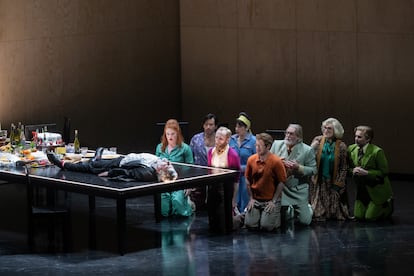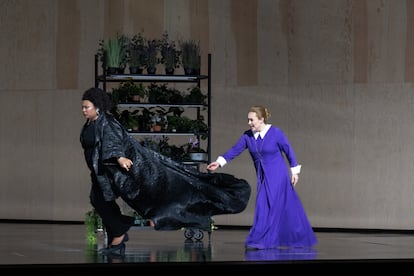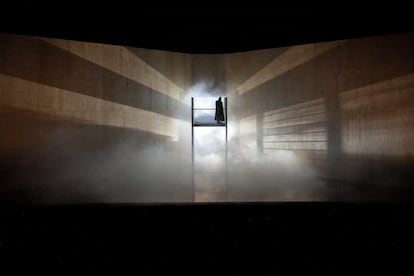The key to success for Giacomo Puccini was to make the audience cry. He confessed this to his librettist Luigi Illica by letter in October 1912: “But do you think it is easy? “It’s terribly difficult.” The composer from Lucca was looking for themes for an old project, perhaps inspired by Hoffmann’s talesby Offenbach: to create an operatic organism in three parts that combined the tragic, the sentimental and the comic.
He read Daudet, Gorky and Mirbeau, without ever forgetting Dante. In the end he opted for naturalistic tragedy The cloakby Didier Gold, para The tabard. And he found, in the playwright Giovacchino Forzano, the ideal collaborator for the sentimental window of Sister Angelica and the macabre comedy of Gianni Schicchi, inspired by Dante. The result was heterogeneous and difficult to baptize; “Triptych” arose after discarding other previous options from “tripod” and “triangle” to “trinity” and “tritone”.
Stage directors usually look for links to connect the three sides of The triptych, when they do not combine one of its parts with another short opera. In the last production seen in Spain, in November 2022, Lotte de Beer wove its management around death and lies, at the Liceu in Barcelona. That same year, Christof Loy chose to reinforce his unity, at the Salzburg Festival, with Gianni Schicchi at first. But Barrie Kosky, in his new production for the Netherlands National Opera, premiered last Friday, May 3, has chosen to individualize these three small operas by Puccini. “As if they were three courses of a meal,” he acknowledged in the hand-held program.
It was the third and last production of the manager Australian, in Amsterdam, as part of the commemoration of the centenary of Puccini’s death. And, after converting Tosca in a violent psychodrama with airs of Tarantino, or represent Turandot with the protagonist always hidden, something equally iconoclastic was foreseen for The triptych. But Kosky has trusted more than ever in his infallible direction of actors to achieve maximum theatricality with minimum scenic performance. A simple timeless set by Rebecca Ringst reduced to a corner wall as a background, magnificent lighting by Joachim Klein and precise costume design by Victoria Behr.
At the beginning of The tabard we see Michele’s barge on the Seine turned into a scaffolding. Then it will be a hallway and even an oppressive room to reflect the tension with his wife Giorgetta. The atmosphere of the Parisian dockworkers, to which her lover Luigi belongs, is reduced to a minimum, although each secondary character is outlined, with a sensational creation by Frugola. And choose an ending big puppet where Michele kills his wife after stabbing his lover and hiding him with his tabard. However, the biggest problem comes from the off-stage voices that are virtually inaudible.
This problem was resolved in Sister Angelica, with an invisible staircase behind the wall. Once again, the convent world is limited to the maximum, with a simple purple wardrobe and a plant cart as the only props, although we end up differentiating almost each of the nuns. The scene with La zia principessa was one of the best moments of the night, along with the suicide of Suor Angelica, after sprinkling herself with the ashes of her dead son.
A comical dessert
But, after the main course, it was the comical dessert of Gianni Schicchi where Kosky’s theatrical genius literally overflows. The Australian chooses to add a scene, prior to the start of the music, where we see the death of Buoso Donatti during a family celebration. The action is as hilarious as it is grotesque and the music starts with laughter from the audience. And the spark will not fade in the rest of the opera with another masterful direction of actors and nods to Buñuel’s cinema.

Lorenzo Viotti’s brilliant musical direction has contributed to the unquestionable success of this production. An admirable sound quality, led by the Nederlands Philharmonisch Orkest, although with radical dynamic extremes that did not always provide dramatic tension and sometimes covered the voices. The Swiss maestro, who will visit Spain in June at the head of the Vienna Philharmonic, extracts all his modernity from Puccini’s score, although at the cost of part of his Italianness.
We checked it at the beginning of The tabard. With the Seine theme, which opens the work and sounded like Debussy and, shortly after, with the slightly dissonant waltz of the organ that sounded like Alban Berg. Your direction of Sister Angelica It benefited, however, from exquisite sound plans. But it was, in Gianni Schicchi, where he best combined his personal style with dramatic action. And also where the long pauses he made in several calderones of the score made the most sense.
female power
The immense vocal cast to satisfy all three operas was excellent. Success leaned, however, towards female roles. In The tabard The dramatic power of the African-American soprano Leah Hawkins stood out, as Giorgetta, in her duets with Luigi and Michele, except for a careless pronunciation of Italian.
Her husband was the Spanish-American baritone Daniel Luis de Vicente, who exhibited good tone and musicality in the monologue Nulla! Silence!, although it lacked sufficient dramatic entity to give life to the murderous boss. He was superior in the comic register as a crisp and fluid Gianni Schicchi.
The same thing happened to Mexican-American tenor Joshua Guerrero. His Luigi, in The tabard, sounded lacking in dynamic contrast and somewhat swamped in the treble. But his voice worked better as Rinuccio, in Gianni Schicchiwhere he shone in You are wrong!.

The mezzo-soprano African American Raehann Bryce-Davis elevated the supporting character of Frugola, in The tabardalthough we hear its best moment as La zia principessa, in Sister Angelica. A big, intense and dark voice that was combined with the powerful performance of Elena Stikhina, as the suicidal nun, which formed one of the stellar moments of the night. This Russian soprano provided an ideal dramatic evolution of the character of Suor Angelica with exquisite nuances, in the moving aria Without motherand a brave ascent to high C in pianissimo, in Ah, I’m shipping!.
Another of the most applauded singers was the soprano Inna Demenkova, also a Russian lyricist with exquisite timbre, who exhibited in the character of Suor Genovieffa, in Sister Angelica. But the Lauretta of him, in Gianni Schicchiallowed him to enjoy the only applause interruption of the night: the popular aria Oh my dear daddywhich he sang with a perfectly calculated pout.
This is what Puccini intended when he parodied so many arias for his tragic heroines here. “I want to laugh and make people laugh,” he said in a letter to her friend Sybil Seligman at the end of her life, adding: “I will never do an operetta, but I will do a comic opera: a kind of Rosenkavalier, more fun and organic.” Unfortunately, his unexpected death, on November 29, 1924, convalescing from laryngeal cancer, has deprived us of more corrosive Puccinian comedies.
‘Il trittico’ (‘Il tabarro’, ‘Suor Angelica’ & ‘Gianni Schicchi’)
Music by Giacomo Puccini. Libreto by Giuseppe Adami (‘Il tabarro’) & Giovacchino Forzano (‘Suor Angelica’ & ‘Gianni Schicchi’). Daniel Luis de Vicente, baritone (Michele in ‘Il tabarro’ & Gianni Schicchi in ‘Gianni Schicchi’), Joshua Guerrero (Luigi in ‘Il tabarro’ & Rinuccio in ‘Gianni Schicchi’), Leah Hawkins, soprano (Giorgetta in ‘Il tabarro’), Raehann Bryce-Davis, ‘mezzo-soprano’ (Frugola in ‘Il tabarro’ & The princess aunt in ‘Suor Angelica’), Elena Stikhina, soprano (Suor Angelica in ‘Suor Angelica’), Inna Demenkova, soprano (Suor Genovieffa in ‘Suor Angelica’ & Lauretta in ‘Gianni Schicchi’), between others. Chorus of the National Opera. Nederlands Philharmonisch Orkest. Musical direction: Lorenzo Viotti. Stage Direction: Barrie Kosky. Het Muziektheater, 3 May. Until the 19th of May.
Subscribe to continue reading
Read without limits
_

